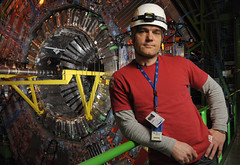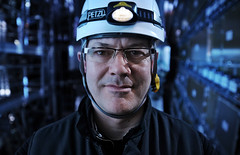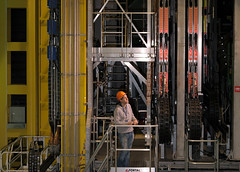__________
 The folks at CERN like to say that the smaller the object, the bigger the detector you need to see it.
The folks at CERN like to say that the smaller the object, the bigger the detector you need to see it. If you want to study a bug, you use a loupe. If you want to study bacteria, you use a microscope. If you want study subatomic particles, you use a proton accelerator that is 27 kilometers around and has detectors that are as much as eight stories tall.
Fortunately, that's exactly what they have hanging around at the Large Hadron Collider at CERN near Geneva, Switzerland. And that's where I was last week, to shoot some photos and teach a workshop.
Reader's Digest version: Best. Trip. Ever.
And suffice to say that, for a while at least, it is gonna be pretty hard to impress me with your run-of-the-mill photographic background.
Would You Like to Come to CERN?
"What would it take to get you to come to CERN to teach?" asked the email. It was from reader Peter Kelemen, who manages computer storage at the research consortium.
He only had to ask. The LHC is
I was traveling with my friend Aaron D'Souza, which was a good thing. He actually understands this particle physics stuff. And he can very effectively translate it into the monosyllabic grunts that comprise my vocabulary on the subject, too.
It worked like this: I would ask him a question, he would know exactly what I was asking, and then take a moment to see just how far down into layman's terms he needed to dip to where I could understand him.
If I did understand it, or even a small part of it, that was considered a significant linguistic victory for both of us.
So, after blasting through our jet lag with the help of a little Five-Hour Energy, we arrived at CERN ready to see how the secrets of the universe would be unlocked. I would get to some of the people there, using the experiments as a backdrop.
Our guide on the first experiment, ATLAS, was Doris, who is a computer whiz specializing in data acquisition. Doris is to data acquisition as to Bill Gates is to wealth acquisition. Except for Bill is a few orders of magnitude behind her.
ATLAS is ginormous. Humongous. Frickin' BIG. You ride an elevator 100 meters down into the planet. The detector itself is 25 meters tall and 46 meters long. It weighs as much as a hundred 747 jets and will create nearly ten terabytes of data a day when up and running.
That last part is where Doris comes in. (And you think you have information overload.)
ATLAS is a beautifully symmetrical behemoth that would look right at home on the set of Stargate, except that it is quite real. It has huge, toroid magnets and muon detectors and, well, let's just say that a flux capacitor would not even raise an eyebrow in this joint.
And it is all covered in dark metal now, with only one half being visible at one time. On top of that, our access to the cavernous room is limited to a series of narrow walkways around the sides. So after a few minutes of cursing the photo gods under my breath (en francais, of course) I finally reached the conclusion that the only way to shoot from our vantage point would be in tight, with a wideangle lens.
 I am sorry, but one simply cannot do justice to Doris' s classic cheekbones with a close-in wideangle lens. So we changed lanes and brought Xavier, a security officer, into service as a subject. Xavier has a smiling exterior but inside he is all business. You will remain safe under his watch.
I am sorry, but one simply cannot do justice to Doris' s classic cheekbones with a close-in wideangle lens. So we changed lanes and brought Xavier, a security officer, into service as a subject. Xavier has a smiling exterior but inside he is all business. You will remain safe under his watch. He even carries an iPod-sized cumulative radiation sensor, to make sure none of those subatomic particles are doing bad things to him -- or you. I am telling you, CERN peeps get all the cool toys.
In any case, an in-your-face wideangle portrait with a little attitude of Xavier makes a lot more sense.
 As you can see in this setup shot by Peter Kelemen, we had about zero vertical space in which to light and shoot. For clarification, I define vertical space as the depth of a photo. Which is to say, how much space do I have between my main light and subject, subject to background, etc.
As you can see in this setup shot by Peter Kelemen, we had about zero vertical space in which to light and shoot. For clarification, I define vertical space as the depth of a photo. Which is to say, how much space do I have between my main light and subject, subject to background, etc.Oh sure, we had literal vertical space out the wazoo here in the ATLAS cavern (they actually call it a cavern) but my shooting environment was composed entirely of the narrow walkway you see here. That's about three feet of front-to-back for Xavier, the lighting, and my lard butt.

Key is an umbrella at camera left in real tight in this setup shot by Aaron. It is being held by possibly the most overqualified voice-activated lightstand in the history of the planet. Fons plays a computer the way Yo-Yo Ma plays a cello. Except for Fons uses way, way more notes.
BTW, you tinfoil hats types will appreciate the info I got from Fons regarding the theory that CERN will produce a black hole that will destroy us all. Short answer is, um, yeah, the LHC actually will produce rather a lot of black holes. But they are tiny and not sustainable. So don't go maxing those credit cards out just yet, as Fons assures me that the LHC will not get you out of your obligation to pay them off.
Fons also introduced me to some new gastronomic delights on our trip, the first being jellyfish. (Verdict: Like eating thick rubber bands, only it eventually snaps in two after a good bit of chewing.)
Dish number two was horse steak.
Yeah, I know. But Fons is very allergic to horses, and in the CERN cafeteria he goes by the motto, "Don't get mad -- get even."
He was kind enough to let me try a piece, as I would never have taken the whole plunge on my own. (Verdict: Surprisingly delicious.)
Sorry, Emily. I know you love to ride them and pet them, and I promise to stay away from your trusty Nirvana with my knife and fork. But suffice to say that you and daddy both share a love for horses. Sort of.
Back to the setup shot. In addition to the key light above, you can see our background light. It is crammed into the same railing about 15 feet away and aimed at the ATLAS shrouding. We are not lighting the dark metal cover so much as bouncing some reflections off of it. There is a CTB gel on the flash, too, for a cool color key.
Unseen in the other direction was our fill light for Xavier coming from about 30 feet away (and one story up) at camera right (that's your left as you are looking into the camera). This gets me light on both sides of Xavier's face within our tight space constraints.
We decided to flip on Xavier's head lamp to add a little pop to the photo, too. If there are interesting ambient lights inside the frame, I will always turn them on if only to check to see how they look. In this case, we went with it.
The photo was lit mostly by flash, with the ambient dial down about three stops.
The "Compact" Muon Solenoid
Later that day we got to visit the CMS, which I suspect is the biggest "compact" anything on the entire planet. Michael, seen in the pic at the top of the post, is a damn good photographer in his own right and was our guide for the visit.
He had some stunning photos on the wall that were there to help to educate the King of Belgium, who came through the CMS shortly before we did. Michael showed us a cool little trick by firing his pop-up flash into the mouth of the giant sensor and illuminating the reflective stickers used to measure if the machine shifts during operation.
I liked the effect, and also noticed that if you fired a direct light into the cavity it tended to bounce around on the metal surfaces and come out looking as if it had come from several angles at once. Given we could not get into there to light it, that would help us out a lot.
We set the camera to underexpose the environment by a couple of stops to use the ambient as fill. (You can't easily light something that big and complex with a couple of small speedlights, so you let the ambient help you out.)
In each of the experiments, that was our strategy -- let the ambient do the heavy lifting, suppress it a little, and highlight areas and people with flash.

As you can see in this setup shot by Aaron, we did it all with an umbrella and two small flashes. And a very sexy subject, too. (Easy there, Michael -- I am talking about the CMS.)
The umbrella lights Michael from a second walkway, and also lights the railing for some context. If you look carefully (or click through) you can see a Justin-clamped flash on the walkway behind Michael's feet which fires into the mouth of the CMS.
The power levels were surprisingly economical -- 1/16th on the key and either 1/4 or 1/8 (can't remember) on the CMS light. Huge areas, but dark. Don't try to nuke them. Expose for them (a little under) and finesse the ambient.
__________
 The next day we toured The LHCb experiment, shooting Niko in a nightmarishly sodium vapor cavern. That is a long post unto itself, so I won't stretch you out any more here today. Did a little french cursing under my breath there, too. Big room full of sodium vapors to fix. But the LHCb looked like a big, beautiful view camera.
The next day we toured The LHCb experiment, shooting Niko in a nightmarishly sodium vapor cavern. That is a long post unto itself, so I won't stretch you out any more here today. Did a little french cursing under my breath there, too. Big room full of sodium vapors to fix. But the LHCb looked like a big, beautiful view camera.  Also, Fons took us to see ALICE, the fourth Experiment on our tour. We threw every light we had at here and she still remained dark and moody.
Also, Fons took us to see ALICE, the fourth Experiment on our tour. We threw every light we had at here and she still remained dark and moody. The very best vantage points for the detectors are pretty much gone now, as the beam pipe (which contains the protons and lead particles used for the various experiments) has been installed. But when they were building the detectors it was possible to see them from a proton's eye view. And some amazing images were made from that concentric viewpoint.
Some of the most beautiful ones were made by CERN's own Max Bryce, and for a tech geek it is practically a religious experience to view them.
At one point on the tour Max muttered some kind of half apology about making some of the shots with just an old Nikon D1X.
Yeah, well, I shot for quite a while with a D1X, too, and I never made a photo anywhere near as cool as some of the ones Max made. The machines are awesome now, but to totally appreciate their beauty you have to see them without their clothes on. You can see many of the early construction shots in a beautiful page done by The Big Picture, here.
__________
Rapping it Up
Last but not least, if you have five minutes I recommend the video embedded below. It totally passes muster with the CERN folks for accuracy -- and does it with style. And for a more thorough tour (with lotsa cool links) of the experiments we visited, check out Aaron's post.
__________
Next week: Inside the CERN Computer Center




0 comments:
Post a Comment